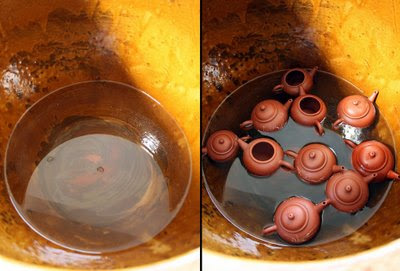This test is best for shuiping pots, also known as "water balance" pots. The first step is to float the pot in the water:

(This floating test has been performed by Maitre.)

(The floating test with a group of pots. by THE MANDARIN'S TEA.)
Here is the next part of test for the quality of the clay:
I've given this a try and found one fake and three real pots in my collection! Today is great day for this kind of test!Pottery Expert: But, as you all know, this floating test will only tell you about the shape of a pot, if it is evenly and beautifully crafted. The test says little about the clay, here however we are mistaken-- yixing clay has a high iron content and often these minerals in the purple sand are very magnetic. So, to find out if you have a true pot float it, then leave it floating for a few hours. If it is real clay it will slowly align itself with true north. You can then use a compass to check. The better lined up it is the better the clay.
There is yet another test you can perform. Sit two pots that you want to test near each other on a very very smooth shelf. Over a few days (if it's smooth enough) they will move closer together. For this to work, you must first do the water test and find out which end of the pot is the 'northern' end. All good craftsmen know about this and hence the best pots have been aligned by the firing process so that north is in the direction of the spout. This is called the "north-endian" school of pottery, though there are those who do not agree and follow the "south-endian" school. (And even those misfits who fire their pots with north in the direction of the lid!)
(Source, the video I transcribed this from is in Japanese, although the tea master in it is Chinese so don't forget to turn on the English captions!)